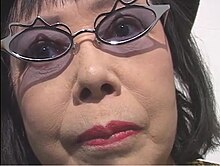Yayoi Kusama 草間 彌生 | |
|---|---|
 Wax model (2012) | |
| Born | Yayoi Kusama (草間 彌生) 22 March 1929 |
| Nationality | Japanese |
| Known for |
|
| Movement | |
| Awards | Praemium Imperiale |
| Website | www |

Yayoi Kusama (草間 彌生, Kusama Yayoi, born 22 March 1929) is a Japanese contemporary artist who works primarily in sculpture and installation, and is also active in painting, performance, video art, fashion, poetry, fiction, and other arts. Her work is based in conceptual art and shows some attributes of feminism, minimalism, surrealism, Art Brut, pop art, and abstract expressionism, and is infused with autobiographical, psychological, and sexual content. She has been acknowledged as one of the most important living artists to come out of Japan,[1] the world's top-selling female artist,[2] and the world's most successful living artist.[3] Her work influenced that of her contemporaries, including Andy Warhol and Claes Oldenburg.
Kusama was raised in Matsumoto, and trained at the Kyoto City University of Arts for a year in a traditional Japanese painting style called nihonga.[4] She was inspired by American Abstract impressionism. She moved to New York City in 1958 and was a part of the New York avant-garde scene throughout the 1960s, especially in the pop-art movement.[5] Embracing the rise of the hippie counterculture of the late 1960s, she came to public attention when she organized a series of happenings in which naked participants were painted with brightly coloured polka dots.[6][7] She experienced a period in the 70s during which her work was largely forgotten, but a revival of interest in the 1980s brought her art back into public view. Kusama has continued to create art in various museums around the world, from the 1950s through the 2020s.[8]
Kusama has been open about her mental health and has resided since the 1970s in a mental health facility which she leaves daily to walk to her nearby studio to work. She says that art has become her way to express her mental problems.[9] "I fight pain, anxiety, and fear every day, and the only method I have found that relieved my illness is to keep creating art," she told an interviewer in 2012. "I followed the thread of art and somehow discovered a path that would allow me to live."[10]
- ^ Yamamura, Midori (2015), Yayoi Kusama: Inventing the Singular. Cambridge, MA: MIT Press.
- ^ Tran, John L. (7 November 2019). "Yayoi Kusama: The underdog story of a Japanese art maverick". The Japan Times. Retrieved 15 January 2023.
- ^ Cite error: The named reference
:1was invoked but never defined (see the help page). - ^ "Yayoi Kusama". guggenheim.org. Archived from the original on 21 February 2018. Retrieved 21 February 2018.
- ^ Griselda, Pollock (2006). Psychoanalysis and the image: transdisciplinary perspectives. Malden, MA: Blackwell Publishers. pp. 127–160.
- ^ "Yayoi Kusama, Harry Shunk, János Kender. The Anatomic Explosion, New York. 1968 | MoMA". The Museum of Modern Art. Archived from the original on 22 February 2018. Retrieved 21 February 2018.
- ^ "Yayoi Kusama, Harry Shunk, János Kender. Mirror Performance, New York. 1968 | MoMA". The Museum of Modern Art. Archived from the original on 15 July 2022. Retrieved 21 February 2018.
- ^ Taylor, Kate (28 February 2018). "How Yayoi Kusama's Infinity Mirrors pushed pop art into the new age". Archived from the original on 15 July 2022. Retrieved 4 March 2018.
- ^ "Yayoi Kusama Biography, Life & Quotes". The Art Story. Archived from the original on 29 February 2020. Retrieved 29 February 2020.
- ^ Swanson, Carl (6 July 2012). "The Art of the Flame-Out". New York. Archived from the original on 26 June 2022. Retrieved 20 February 2020.